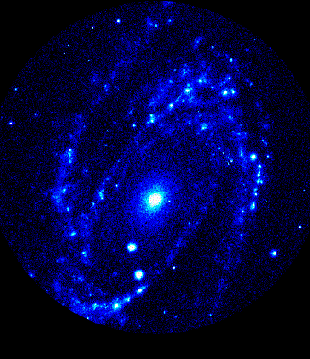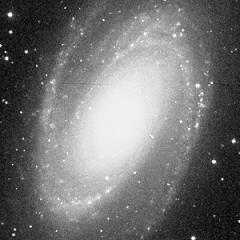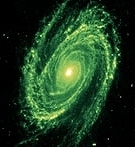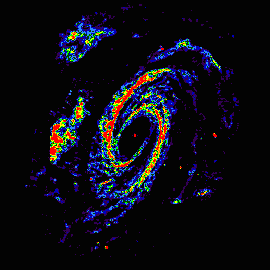|
Radio Emission from Normal Galaxies:
It is understood that a very large black hole resides at the heart of every
galaxy - our own galaxy has one. This object is often called a supermassive
black hole - meaning they are very large, at least 100 solar masses or more.
Material that is near this supermassive black hole will be accelerated and
release very high energy radiation. Galaxies that are undergoing this event is
called an active galaxy. More information on this is found in the
Galaxy
section.
A normal galaxy is one that does not have material for the supermassive black
hole to "feed" on. But even if these normal galaxies are quite in regards to
core activity, they still emit in other wavelengths. There are three sources of
emission outside the optical band in normal galaxies:
- Synchrotron Radiation
- Thermal Emission
- Bremsstrahlung
Thermal emission are the most dominant. This emission comes from the billions
of stars that reside in a galaxy. Synchrotron emission comes from the supernova
remnants of the large stars that have ended their lives in a supernova.
Bremsstrahlung (braking radiation) comes from the emission from HII regions
(ionized hydrogen gas).
An example of a normal galaxy emitting in multiple wavelengths is the spiral
galaxy M81:
 |
 |
| X-Ray Image |
Ultraviolet Image |
 |
 |
| Visible Image |
Near Infrared |
 |
 |
| Mid Infrared |
Far Infrared |
 |
|
| Radio Image |
Image credits |
The X-Ray and Ultraviolet images show areas of intense star birth and
locations of very bright, hot stars. The infrared images show the more cooler
red stars and dust areas surrounding bright stars. The Radio image shows the
distribution of hydrogen through the galaxy. In addition, radio emission can
also result from residual supernova remnants.
In radio and the far infrared, bursts of star formation are optically thin -
the brightness in these regions is a good indicator of star formation rate.
Bremsstrahlung from these regions can sometimes be competitive with synchrotron
radiation but can be difficult to determine. Most easily recognized is
synchrotron radiation at about 1 GHz, which arises from old relativistic
electrons which have moved a long way from the supernova remnants in which they were created. The
supernova remnant
themselves may have long since merged with the interstellar medium and are
no longer visible (C.
Flynn, 2005).
Back to Top
|

